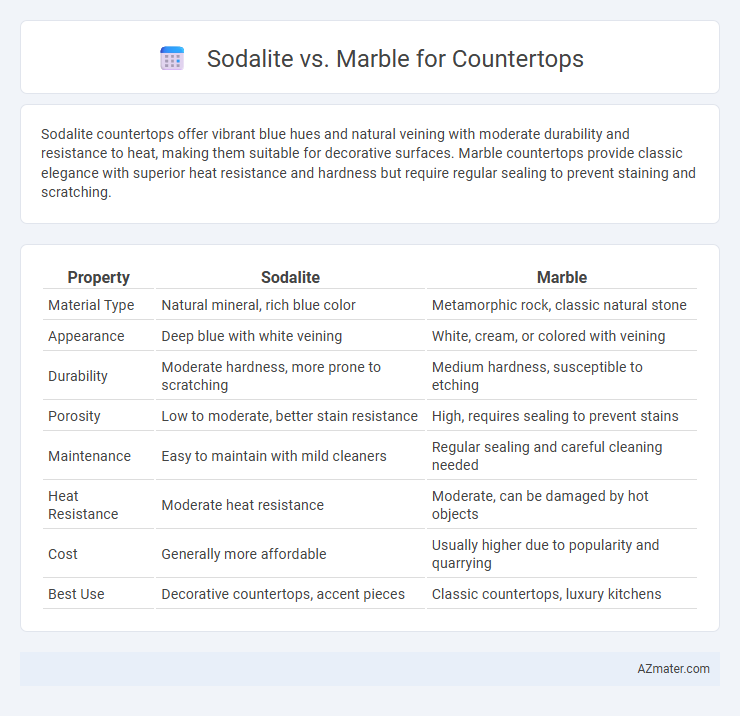Sodalite countertops offer vibrant blue hues and natural veining with moderate durability and resistance to heat, making them suitable for decorative surfaces. Marble countertops provide classic elegance with superior heat resistance and hardness but require regular sealing to prevent staining and scratching.
Table of Comparison
| Property | Sodalite | Marble |
|---|---|---|
| Material Type | Natural mineral, rich blue color | Metamorphic rock, classic natural stone |
| Appearance | Deep blue with white veining | White, cream, or colored with veining |
| Durability | Moderate hardness, more prone to scratching | Medium hardness, susceptible to etching |
| Porosity | Low to moderate, better stain resistance | High, requires sealing to prevent stains |
| Maintenance | Easy to maintain with mild cleaners | Regular sealing and careful cleaning needed |
| Heat Resistance | Moderate heat resistance | Moderate, can be damaged by hot objects |
| Cost | Generally more affordable | Usually higher due to popularity and quarrying |
| Best Use | Decorative countertops, accent pieces | Classic countertops, luxury kitchens |
Introduction to Sodalite and Marble Countertops
Sodalite countertops showcase a rich blue color accented with white veins, offering a unique and striking appearance compared to traditional materials. Marble countertops feature classic elegance with varying patterns of veins in colors like white, gray, or beige, renowned for their timeless beauty and natural stone composition. Both materials provide durable surfaces suitable for kitchen and bathroom applications, but sodalite's rarity and vibrancy create a distinct visual impact compared to the more conventional marble.
Material Composition and Origins
Sodalite countertops are composed primarily of sodium aluminum silicate with rich blue hues derived from their volcanic origins, primarily found in Brazil, Canada, and Russia. Marble, a metamorphic rock formed from limestone, consists mainly of calcite or dolomite crystals and originates from regions like Italy, Greece, and the United States. The distinct mineral compositions and geological formations influence their durability, coloration, and suitability for various countertop applications.
Aesthetic Differences: Colors and Patterns
Sodalite countertops showcase deep blue hues with striking white veining, creating a bold and dramatic aesthetic that contrasts sharply with the more traditional and elegant appearance of marble. Marble offers a wide palette of soft, creamy whites, grays, and subtle veining patterns that provide a timeless and sophisticated look. The intense color saturation in sodalite makes it a focal point in interior design, while marble's classic translucence and delicate veining allow for versatile and understated elegance.
Durability and Hardness Comparison
Sodalite countertops offer moderate durability with a Mohs hardness of around 5.5 to 6, making them more susceptible to scratches and chips compared to marble, which typically rates between 3 and 5 on the Mohs scale but varies depending on the type. Marble provides a classic aesthetic but is softer and more prone to acid etching and staining, whereas sodalite's higher hardness makes it slightly more resistant to everyday wear and tear. For long-lasting countertop surfaces, sodalite generally outperforms marble in hardness, but care must be taken with both materials to maintain their appearance.
Maintenance Requirements
Sodalite countertops require regular sealing to prevent staining due to their porous nature, while marble demands frequent polishing and sealing because it is highly susceptible to etching from acids and scratches. Both materials need gentle, pH-neutral cleaners to maintain their surfaces without damage. Marble's maintenance is more intensive compared to sodalite, making sodalite a more practical option for homeowners seeking lower upkeep.
Stain and Chemical Resistance
Sodalite countertops exhibit superior stain resistance due to their dense mineral composition, making them less prone to discoloration from acidic substances compared to marble. Marble, composed primarily of calcite, is more porous and susceptible to etching and staining when exposed to acidic foods and chemicals. For kitchen use, sodalite offers enhanced durability against chemical damage, maintaining its appearance with less frequent sealing and cleaning precautions.
Heat Tolerance and Usage Suitability
Sodalite countertops offer moderate heat tolerance, making them suitable for kitchen use but requiring protection from direct contact with hot pots or pans to avoid thermal damage. Marble, while elegant and heat resistant to a degree, is more prone to heat-related stains and etching, thus less ideal for high-heat kitchen environments. Both materials require careful maintenance; sodalite is better for decorative surfaces, whereas marble suits low-use areas where heat exposure is minimal.
Cost Comparison: Sodalite vs Marble
Sodalite countertops typically cost between $50 and $80 per square foot, making them a more affordable option compared to marble, which ranges from $75 to $250 per square foot depending on the grade and origin. The installation of sodalite is generally less expensive due to its relative abundance and ease of sourcing, whereas marble's higher cost is driven by quarrying, transportation, and finishing processes. Maintenance costs also vary, with marble requiring more frequent sealing and care to prevent staining, adding to its overall expense over time.
Environmental Impact and Sustainability
Sodalite countertops offer a more environmentally sustainable option due to its lower quarrying energy consumption and resistance to chemical treatments compared to marble. Marble extraction and processing generate higher carbon emissions and often involve extensive quarry disruption, impacting biodiversity. Choosing sodalite supports eco-friendly building practices by reducing pollution and resource depletion while maintaining durability and aesthetic appeal.
Choosing the Best Stone for Your Needs
Sodalite countertops offer deep blue hues with unique white veining, providing a striking, distinctive look compared to the classic elegance and wide color range of marble. Sodalite is moderately durable and less porous than marble, making it better suited for kitchens where stain resistance and low maintenance are priorities. Marble, prized for its timeless beauty and heat resistance, requires regular sealing to prevent etching and staining, making it ideal for areas where aesthetic appeal is paramount and care is manageable.

Infographic: Sodalite vs Marble for Countertop
 azmater.com
azmater.com